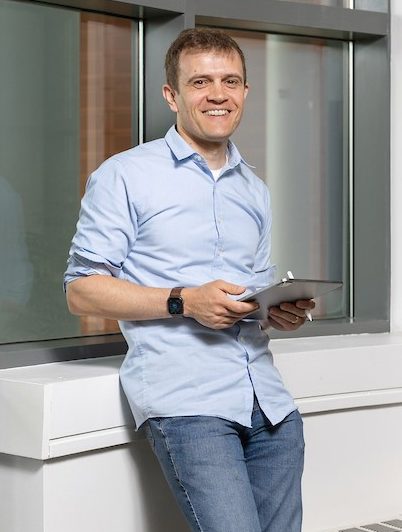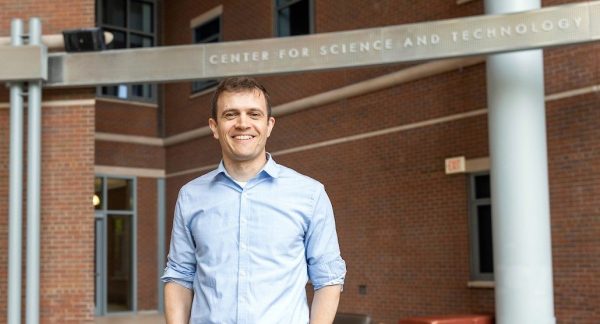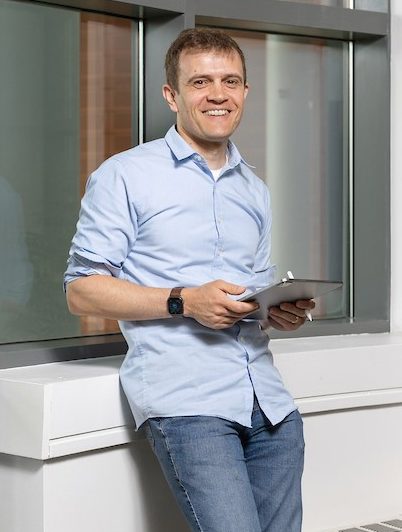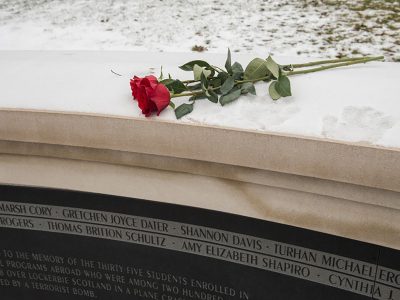Collin Capano ’05, G’11 Breaking New Ground With Open Source Program Office and Astrophysics Research
Collin Capano ’05, G’11, director of the University’s new Open Source Program Office (OSPO), has been in the right place at the right time for breakthrough discoveries and innovative programming several times in his career.
His latest role is another opportunity to break new ground, and it’s also a homecoming for the double alumnus.
The OSPO is a multidisciplinary, cross-campus initiative intended to accelerate research and creative work by leveraging the use of open-source software code and adherence to open-source best practices. It is one of only about a dozen such offices operating at U.S. universities, so offers a chance to make high impact in that academic space and enhance the University’s research reputation through information and transparency, Capano says.

Also a physics research associate professor in the College of Arts and Sciences, Capano will continue his research in gravitational-wave astronomy while he directs OSPO, he says.
After earning bachelor’s and doctoral physics degrees at Syracuse, he gained more than a decade of experience in open-source code development and extensive experience in multi-messenger data analysis, statistics and high-performance computing. He has worked as a member of the LIGO (Laser Interferometer Gravitational-Wave Observatory) Scientific Collaboration as a postdoctoral scholar at the University of Maryland and as a high-performance computing facilitator and affiliate physics and math faculty member for the Center for Scientific Computing and Data Science Research at the University of Massachusetts, Dartmouth.
Perhaps his most distinctive “right place/right time” opportunity came in 2015 at the Max Planck Institute for Gravitational Physics in Hannover, Germany, the largest research institute in the world specializing in general relativity, where he did postdoctoral research. Serendipitously, he was among the first scientists to observe the first detection of gravitational waves from a long-ago collision of black holes in space. It was a monumental discovery that confirmed part of Albert Einstein’s theory of relativity developed 100 years prior.
Capano, who grew up in the Adirondack town of Corinth, recently discussed plans for OSPO, his current research and what that breakthrough gravitational wave detection moment was like.
What led you back to Syracuse?
I was invited to apply for the OSPO director position and it sounded very interesting. It also presented a great opportunity to be closer to family again and for my daughter to grow up near her grandparents. And the things going on in Syracuse right now—Micron coming in and the Route 81 redevelopment—are exciting. The region is beginning a Renaissance, and the University is on an upswing too. I’m excited to be part of the changes and see how the investment and growth plays out. It seems like a once-in-a-century thing.
What has been accomplished at OSPO so far? What’s ahead?
Over the past year, I got the office up and running. Now, I’m promoting open-source culture across the University and encouraging faculty and researchers from all disciplines to make their source code and research data available beyond campus and to the public. That transparency helps instill confidence in their research results and can gain wider recognition for the work.
We’re now developing workshops for faculty, students and staff on coding processes and tools; campuswide seminars and speaker presentations; perhaps a student code hackathon. I’m also working to have open-source code development as part of the standard considered for faculty promotions.
How did you become interested in physics research? What drew you to astrophysics and gravitational wave research?
My dad, who had a master’s degree in physics and was an electronics engineer, used to tell me fascinating things about relativity and quantum mechanics, and that piqued my interest.
In my second year of graduate school, I needed to pick a research advisor. I was a teaching assistant for a course on electricity and magnetism, but I wasn’t sure what I wanted to do. It was also Duncan Brown’s first semester as a professor here, and one night we sat together as we graded exams. Duncan [now a world-renowned gravitational wave expert, the University’s vice president of research and Charles Brightman Endowed Professor of Physics] asked if I’d like to do an independent study. I did, and I’ve stayed with it.
I already knew of the gravitational wave group and the idea of doing experimental gravity appealed to me. If it weren’t for the two of us grading exams that night, I might have gone an entirely different route. I’m very glad I didn’t; I have been part of some once-in-a-lifetime experiences.
What do your two National Science Foundation research projects examine?
My research focuses on testing basic principles of gravity and nuclear physics using gravitational waves.
One project explores Einstein’s theory of relativity by testing it in extreme conditions near black holes using data from the LIGO detector to see whether the waves match Einstein’s predictions or if they reveal unexpected patterns. The other involves creating a cluster of Apple computers to accelerate the search for gravitational waves using LIGO data. That can help make gravitational wave research less costly, allowing for more ambitious searches, and making it possible for more researchers to contribute to the field.

What was it like at the front line of the first gravitational wave detection—one of the greatest physics discoveries of all time?
I was at The Max Planck Institute, which was affiliated with LIGO and worked closely with the Syracuse gravitational wave analysis group. On that day a couple of colleagues in the office next to mine got an automated alert about a detection of the collision of two black holes in space. They excitedly banged on my wall; I came over and they showed me a plot of the data that showed the characteristic “chirp” signal.
We were some of the first researchers to see it, and the moment was surreal. My first reaction, and that for many others, was that it was a mistake. The lab could simulate those signals and did so regularly to test the infrastructure. When the control room confirmed that they hadn’t done a test, that’s when the reality sank in. The whole thing was a whirlwind! As co-chair of the LIGO subgroup devoted to exactly that type of signal, I was later in charge of compiling the data analysis on the event.
[Capano was one of 1,000 LIGO-affiliated scientists whose contributions were recognized for detection of the waves, earning them the Gruber Cosmology Prize and the Special Breakthrough Prize. In 2017, three LIGO scientists were awarded the Nobel Prize for Physics for the discovery.]
What next for gravitational wave research?
It’s a very bright and exciting future. Syracuse is a big part of it. We are laying the groundwork to build the next-generation detector, Cosmic Explorer, that will be able to detect every black hole merger occurring in the universe.
Pushing the frontiers of physics can lead to new, practical things in life—like how the discoveries surrounding magnetism and electricity affected the entire modern world. My hope is that future discoveries about gravitational waves will do the same and that over the next 20 years, we’ll uncover new fundamental findings about the universe.



